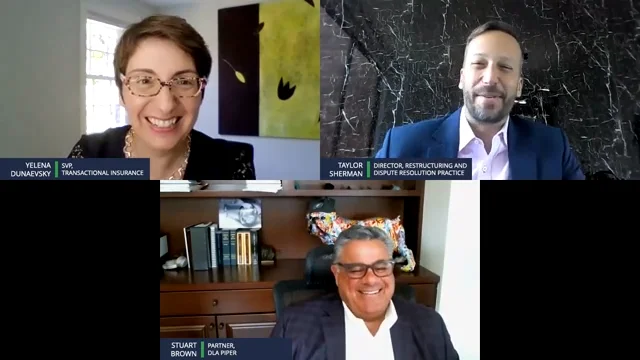Blog
SPAC Bankruptcies: Challenges and Practical Tips
In a recent poll of our SPAC Notebook audience, SPAC-related bankruptcies were the number one topic of interest. To delve into this timely subject, we spoke with two industry leaders—Stuart Brown, an insolvency, restructuring, and bankruptcy partner of the global law firm DLA Piper, and Taylor Sherman, director in the Restructuring and Dispute Resolution Practice at CohnReznick, an advisory, assurance, and tax firm.
In addition to providing an analysis of the legal, financial, and insurance issues involved in SPAC-related bankruptcies, we discussed tips for newly de-SPACed companies that may be heading in the bankruptcy or restructuring direction.
Here are some highlights from our conversation. You can also watch the full discussion below.
An Overview of Current SPAC Challenges
Yelena Dunaevsky: SPAC-related bankruptcies have been coming up on my radar over the last couple of months. I've been seeing a lot of media attention devoted to some of the recent bankruptcies that followed de-SPACs. What are you seeing?
Taylor Sherman: The boom in activity in 2020 and 2021 has led to some challenging situations for companies that previously went public through a de-SPAC merger.
| When looking back at the 20 or so companies that have filed for bankruptcy—be it Chapter 11 or some in Chapter 7—what stood out to us was the high levels of redemptions ahead of the de-SPAC merger, which were north of 80%. |
Many of these companies in Chapter 11, nine out of 10 or so, backfilled the liquidity cash shortfall from the de-SPAC merger with some form of secured or unsecured debt. Rising interest rates, a challenging operating environment, and less liquidity tend to lead you towards few alternatives—one of them being a Chapter 11 restructuring.
Stuart Brown: There are differences in de-SPAC approaches to bankruptcy. One of the most compelling issues is the longevity of governance. You see the old company pre-merger governed by visionaries who developed the technology, who are creative, and who oversaw early-stage, mid-stage revenue companies before they entered into a SPAC. They were fortunate to obtain astronomical enterprise values in terms of what the potential for the market was or is.
The market may not necessarily absorb all that growth so quickly, especially with all the competition and tightening capital markets since interest rates started to go up. With a de-SPAC bankruptcy and insolvency situation, we would look at the burn rate, the old governance, and the new governance, and whether they're cooperating with respect to:
- Changing the business plan
- Preserving cash
- Stopping spending on growth and development
- Focusing on core fundamentals
- Preserving the business and the core assets so that they can be transferred through a sale process or a recapitalization through a bankruptcy reorganization plan
This is fundamentally different from a public company that has been operating for a number of years and is looking to de-leverage its balance sheet—and is essentially looking for a balance sheet restructuring. A de-SPAC's goals in restructuring, on the other hand, are to sell the assets to new investors who want to take the vision and carry it forward.
What About the Insurance Side?
Yelena Dunaevsky: From an insurance perspective, you need to think about the limits. My first tip is to carefully think about the limits of coverage that would be sufficient to carry you through these processes.
And it's not only the directors and officers of the combined post-merger company who should be thinking about the sufficiency of the limits. The SPAC's Ds and Os should be thinking about the tail coverage they want to put in place ahead of the merger with an eye on possible bankruptcy as an outcome down the road.
After the transaction's closing, some Ds and Os may walk away thinking they are free and clear. Even in the non-bankruptcy or restructuring context, most of the litigation that has come post-de-SPAC has pulled in not only the directors and officers of the go-forward entity, but also the Ds and Os of the SPAC.
Once you get pulled into that lawsuit, it's too late to go back and say you want additional limit. Also, once you get into or close to bankruptcy, the company is experiencing cash flow and liquidity issues and won't be able to indemnify you.
My second tip is making sure the company pays for that insurance coverage way ahead of filing for restructuring. Restructuring could last a long time and could exceed or fall outside of the typical year-long term for D&O coverage. In that situation, not only do you need to negotiate potential tail coverage to carry you through bankruptcy, but you need to try to pay for that tail ahead of time. If you don't, you'll be fighting with the trustee to get the funds released from the bankruptcy estate to get that payment made.
Developing an Exit Strategy
Stuart Brown: One of the most important things before jumping off the ledge and landing into a bankruptcy case is identifying the strategy to get out of the bankruptcy case.
With SPACs, it's often a sale process. It's another way of raising money for the core assets and core business of the company to permit the company or the assets or the creative vision to live a different life with different owners, with a slightly changed vision of how it ought to go forward.
We're talking about companies that generally have a liquidity crisis or dwindling liquidity. So, the second thing we focus on is cash preservation. For example, if you have an R&D department, you should be shutting that down. You want to make sure the funds are utilized for the things that create and preserve the core value.
Taylor Sherman: It is about contingency planning, even upfront, when going through the merger process. We saw a lot of people with very positive, aggressive outlooks and they forwent some of these opportunities to invest in preserving shareholder value—through, for example, a robust insurance policy. We also saw a lot of people with lofty evaluations choosing to forgo a fairness opinion or get that kind of advisory support.
I understand it because it is hard to quantify the return on that investment until things go wrong. By not taking those steps and not making those investments, what's the cost to those shareholders? It's heavy.
When you're evaluating or restructuring, cash is king for preserving liquidity, extending that runway, and leveraging experience.
Fairness Opinions
Yelena Dunaevsky: We're still waiting for the SEC rules to be finalized. One of the things many SPACs started doing after the proposed regulations came out was to move forward with obtaining the fairness opinion as a standard as they get into closing.
Stuart Brown: I'm a fan of fairness opinions even though their cost is generally high. They demonstrate a contemporaneous approach and attention to the fairness of the transaction.
Suppose one of the parties to the transaction is determined on the transaction date to have been insolvent or rendered insolvent as a result of the transaction. In that case, the fact that you obtained a fairness opinion speaks to the reasonableness and equivalence of the consideration being exchanged between the parties. You can demonstrate to a jury or court that you've thought about that at the time because the relevant period is at the time of the transaction.
The best defense to a fraudulent transfer case is one that's built contemporaneously with the transaction because anything done in hindsight can be challenged for credibility issues.
Taylor Sherman: That's where we saw a lot of litigation that took off in 2022. The nature of a de-SPAC merger puts a lot of pressure on the management team, who often have not run a public company before. That opens up the door for many things to be challenged down the road.
| Even with the best intentions and a lot of hard work done, there are opportunities there for litigators to pick stuff apart, and taking the time to bring counsel in or even a financial advisor to support you and get in front of those issues reduces that risk. |
As you think back to those situations where you see that litigation, it was likely a transaction that moved very quickly, and management put forth an aggressive plan that was attractive to investors. It may not have been defensible later on when issues like litigation or an SEC inquiry arose.
How to Maximize D&O Protection
Yelena Dunaevsky: Although it's not a SPAC-related transaction, the recent Silicon Valley Bank (SVB) case has an interesting element that is relevant from the insurance side. The court there focused on the priority of payments provision.
My third tip from the insurance perspective is to pay attention to the priority of payments provisions in D&O policies. The idea behind this provision is to lay out clearly who gets paid first in case the policy is tapped. Many of us know there are usually three levels of coverage in the D&O policy:
- Side A covers the directors and officers for non-indemnifiable claims.
- Side B covers the company for indemnifying those directors and officers.
- Side C covers the company in case there's a lawsuit like a securities class action brought against the company.
In the SVB case, the creditors argued that the directors and officers should not get their defense fees covered because the policy proceeds should be considered a part of the estate. But the judge said the priority of payment provision was crystal clear, that the Ds and Os should get coverage first, and that the creditors and everyone else would have to wait.
Stuart Brown: I see it often where a creditor's committee chasing a D&O claim or company chasing a D&O claim seeks to restrict access to the policy benefits to defense counsel for defense costs, arguing that the policy is self-liquidating and that it diminishes the benefits available to pay creditors. This stance disregards the notion that the Ds and Os may have accepted their positions as Ds and Os based on the policy being in place or with the thought of deriving benefit from it.
How Will SPAC-Related Bankruptcies Play Out?
Taylor Sherman: From a big-picture perspective, upfront contingency planning and investment go a long way in terms of preserving shareholder value. Additionally, if you're going to do a deal and you see a high redemption rate, be confident that you can then satisfy that business plan or redo that business plan with that lower level of capital.
Stuart Brown: A couple of additional points to consider—first is one fundamental bankruptcy question we ask clients at the beginning of a representation: "Is there a reason for this company to exist today or tomorrow?" If the answer is "Maybe," you try to save it. But if your company is clunky and has mediocre technology, the answer may be "No." A different path forward other than reorganization or preservation should be followed.
And the second is that the minute you start talking about bankruptcy, the directors are thinking they’re going to get sued and wondering if they should stay or resign. Think of it this way—if you leave, you are still going to get sued, but if you stay, you'll get a release at the end of the bankruptcy.
Yelena Dunaevsky: It is important to keep in mind there are many avenues for companies to grow and evolve, whether it's through a de-SPAC, a traditional IPO, or staying private. Getting ahead of a potential liquidity crunch and subsequent need for restructuring through financial, insurance, and legal planning is key to achieving a positive outcome for a de-SPAC merger. It is never a bad idea to reach out to your legal, financial, and insurance advisors to run through potential scenarios ahead of major business decisions.
Visit our SPACs industries page for more insights and resources related to Special Purpose Acquisition Companies.
Author
Table of Contents










